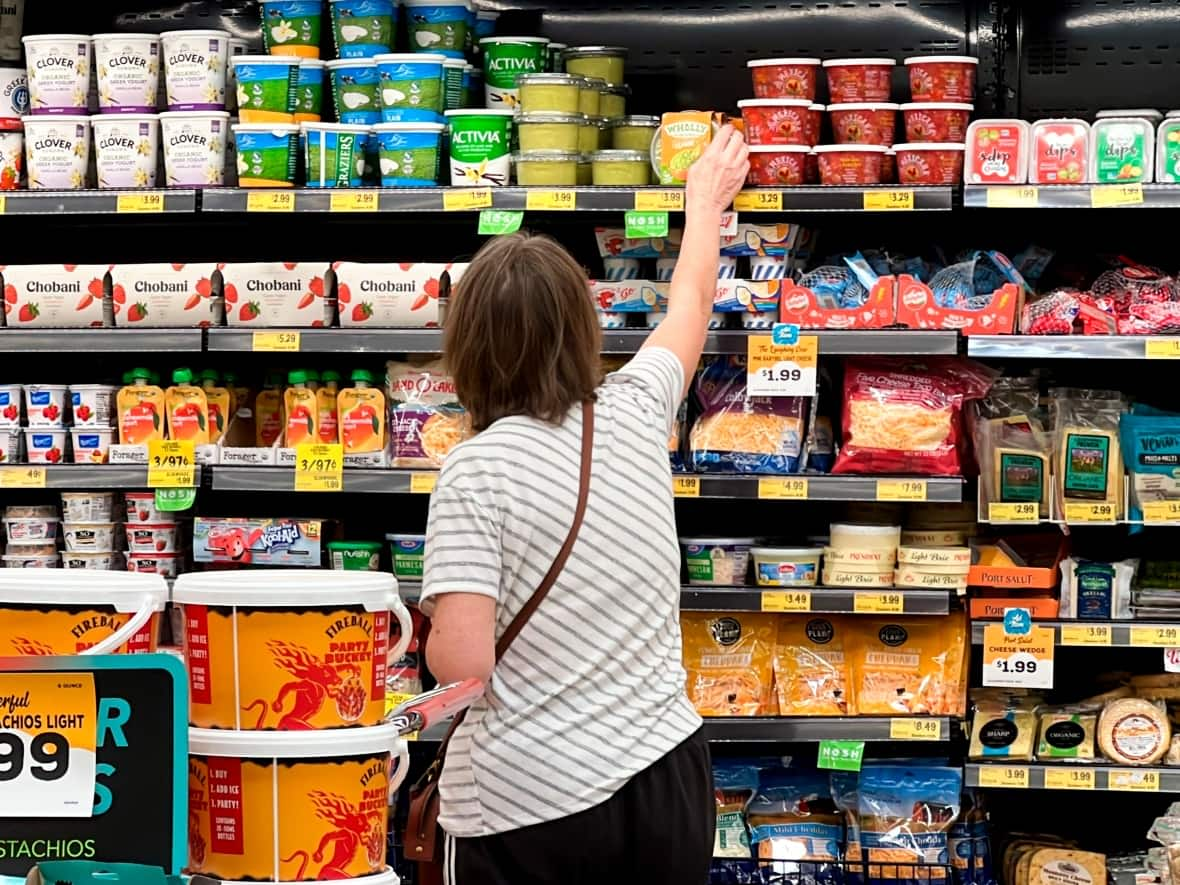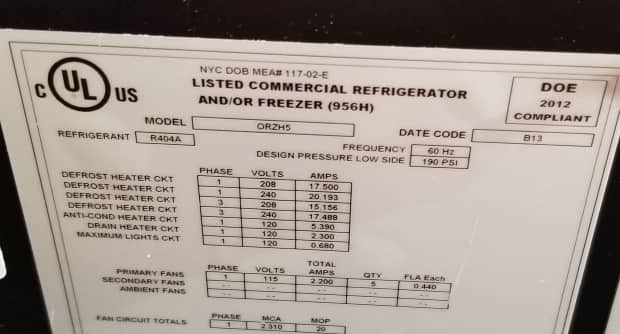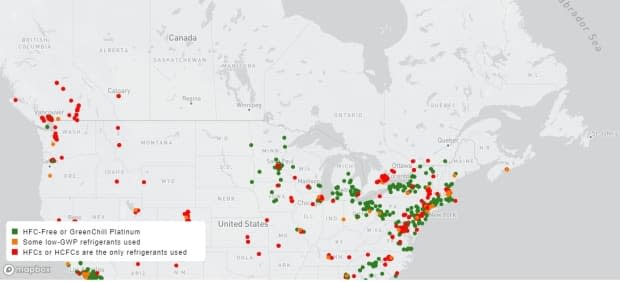How supermarket freezers are heating the planet, and how they could change

Climate-conscious shoppers may buy local food and try to cut packaging waste, but those efforts could be negated by potent greenhouse gases leaking from supermarket fridges.
Refrigerants called hydrofluorocarbons or HFCs are widely used to keep food cold or frozen at grocery stores and during transport. (They're also used for other refrigeration applications, like ice rinks and air conditioners).
They were originally brought in to replace ozone-depleting refrigerants called chlorofluorocarbons (CFCs), which were banned in a landmark 1987 agreement called the Montreal Protocol, in order to save the Earth's protective ozone layer.
But HFCs are themselves powerful greenhouse gases.
Typically, each tonne of HFCs can trap as much heat in the atmosphere as 1,400 to 4,000 tonnes of carbon dioxide over 100 years, depending on the type of HFC.
Do you have a question about climate change and what is being done about it? Send an email to ask@cbc.ca
Common refrigerants used in supermarkets
Here's a look at why that's happening, what the solutions are, and how ordinary shoppers could make a difference.
How do HFCs get from supermarkets into the atmosphere?
Supermarket fridges aren't like your fridge at home, which typically contains less than 200 grams of refrigerant. And it's in a sealed unit that's unlikely to leak, says Morgan Smith, spokesperson for the North American Sustainable Refrigeration Council.
Her non-profit group has partnered with industry to help enable the transition from HFCs to more climate-friendly refrigerants because the complexity of their systems make them prone to leaking significant amounts of HFCs.
Beneath and behind the cases of vegetables, dairy and frozen foods at a typical supermarket are kilometres of piping with thousands of valves, containing literally a tonne of refrigerant.
"It's so large and so complex, with so many different points of connection that those systems are inherently leaky, and so they leak about 25 per cent of their refrigerant charge every year," said Smith.
That's something another non-profit group called the Environmental Investigation Agency has captured on video using infrared cameras and HFC detectors in U.S. grocery stores. It also measured levels of HFCs in the store using chemical detectors.

It detected leaks at 55 per cent of the dozens of U.S. stores where it took measurements. On average, it found a single supermarket emits 875 pounds (400 kilograms) of HFCs a year, equivalent to carbon emissions from 300 cars. In the U.S. alone, it calculated supermarket HFC leaks cause as much global warming as burning 22 million tonnes of coal.
How big a deal are these emissions really?
HFCs are such a big problem for climate change that Canada and 196 other countries have signed an international agreement, the Kigali Amendment to the Montreal Protocol, to reduce HFC consumption 85 per cent by 2036, relative to 2011 to 2013.
Sheli Miller, a professor who studies the environmental impact of the food system at the University of Michigan, says emissions from refrigerants may be relatively small compared to the food system emissions overall and major categories such as food waste.
"But that's also just because the food system has such a big impact," she said.
On the other hand, targeting HFCs in supermarkets can be very effective at curbing emissions.
"You can make fairly small changes and have a relatively large impact just because the chemicals themselves that we're using right now have such large global warming potentials," Miller said.
While potent, HFCs are short-lived greenhouse gases, said Miller, lasting no more than 30 years in the atmosphere, compared to hundreds of years for CO2. Since a typical refrigeration system lasts about 30 years, decisions made now about what refrigerant to use can affect global emissions for decades.
"We need to be thinking about the sources and the hubs of where emissions are happening. And so our grocery stores are a great way to target our overall food system and reduce emissions."
WATCH | How the Environmental Investigation Agency measured HFCs:
Project Drawdown is a U.S.-based nonprofit organization focused on identifying and supporting the most effective climate solutions. It has consistently listed preventing refrigerant leaks and replacing HFCs with more climate friendly refrigerants among its top climate solutions, capable of reducing CO2 emissions by more than 100 billion tonnes by 2050.
What can be used for refrigeration in place of HFCs?
The main alternatives are called "natural" refrigerants because they are all chemicals found in nature. They include:
CO2.
Ammonia.
Propane.
While CO2 is a greenhouse gas, its global warming potential is so much lower than that of HFCs. And propane, while it's a fossil fuel, is not burned when used in refrigeration. In fact, all three of these chemicals are considered refrigerants with ultra-low global warming potential.
How are Canadian supermarkets progressing at switching away from HFCs?
According to Shecco, a market research firm focused on sustainable technologies, there were 340 commercial CO2 refrigeration installations in Canada as of May 2020. That was far fewer than Japan, with 6,500 and Europe with 29,000, and growing more slowly than every other region in the world listed, including the U.S., Australia and New Zealand.
However, Jeffrey Gingras, president of Evapco LMP, a Laval, Que.-based company that makes CO2 refrigeration systems, said he's seen an exponential growth in installations in the past three years, and did a record 125 installations in supermarkets, about half of them in Canada, in 2022.
The Environmental Investigation Agency has been building a global map of refrigerants used in supermarkets since it launched its Climate-Friendly Supermarkets project in 2019.
Two Canadian community groups, Drawdown Toronto and Drawdown B.C., have helped coordinate submissions to the map in their regions, and have added about 250 stores to the map. (Note: I volunteered for Drawdown Toronto while on leave from CBC News and added one store. You can read more about that in our What On Earth newsletter.)

That was enough for the EIA to issue its first ever scorecard on Canadian supermarkets last fall.
It reported on the five largest food retailers in Canada: Costco, Loblaws, Metro, Sobeys and Walmart.
The best-performing was Sobeys, which had the highest percentage of stores using ultra-low global warming potential refrigerants (nine per cent), was the only listed company that publicly reports its refrigerant leak rate (seven per cent) and has committed to transition to climate-friendly refrigerants for all new stores and renovation projects starting in 2024.
Some stores have also reported taking their own actions on HFCs, including Loblaws, which ranked third in the report and told CBC News that it has cut its greenhouse gas emissions by 30 per cent "in a large part" because of its strategy to reduce refrigerant leaks: using less refrigerant, detecting leaks early and reducing the emissions intensity of the refrigerants it uses.
Walmart Canada, which came fourth in the report, told CBC News in an email that it is installing natural refrigerants in all new stores and during major remodels with new grocery departments, and will switch all stores running on HFC refrigerants to more environmentally friendly options. It did not give a timeline, but said its global operations are aiming for zero emissions by 2040.
The other companies did not respond to CBC's requests for comment.
EIA's global map does show very few green dots in Canada compared to the U.S. and Europe. Avipsa Mahapatra, the group's climate campaign lead, said that may be because no Canadian supermarket chains have not submitted their own data, unlike in other countries, and there isn't much information.
"I actually have a hunch that Canada is not very far behind," she said.

Why aren't HFCs getting ditched faster?
Morgan Smith of the North American Sustainable Refrigeration Council said making the switch to natural refrigerants isn't easy. They may require different training and equipment: ammonia is toxic, propane is flammable, and CO2 operates under very high pressures.
Smith said CO2 tends to be the natural refrigerant of choice for most supermarkets because it's non-toxic and its systems work a lot like HFC systems.The high pressures mean it does need different piping and different valves, so a system can take months to build, and can't just be swapped out overnight like parts of the existing system when it needs repairs.
It's easiest if you have the space to build a new system alongside while the old system is still running, Smith said. Otherwise, you might have to shut down the store during the retrofit, which is difficult for both customers and the store operator.
For smaller stores, one option is to switch to individual fridges similar to your home fridge, with propane refrigerant in a sealed unit, Smith said.

Michael Zabaneh of the Retail Council of Canada said refrigerant projects are quite expensive for supermarkets.
"They can be challenging and that's probably the biggest barrier, the need to pay for higher capital costs to either upgrade the equipment so that it can handle natural refrigerants, or buy new equipment."
However, he said most large grocery chains are aware of the problems with HFCs and customer and investor pressure to reduce greenhouse gas emissions, and are taking action.
The Environmental Investigation Agency's Mahapatra acknowledged that retrofitting older stores is expensive and challenging. However, she says grocery chains should be making all new stores use natural refrigerants.
"There is no excuse for any supermarket today to build a new store that still contains HFCs. That is just simply foolish," she said, noting that international agreements to phase out HFCs will eventually force companies to change the systems anyway.
What is the government doing about this?
The federal government will start to offer carbon offset credits for projects that cut refrigerant emissions, including those in supermarkets. Environment and Climate Change Canada told CBC News in an email that they'll go into effect "in the next few months." Once that happens, companies will be able to apply to get credits for projects that started as far back as January 1, 2017.
Federal regulations have also been brought in to comply with the Kigali Amendment, the international agreement on HFCs that went into effect in 2018, with reduction targets starting in 2019.
The regulations will start to ban the manufacture and import of certain equipment containing HFCs with a global warming potential above a specific limit.
Gingras said the Quebec government did offer incentives for a period of time starting 2014 that made natural refrigerant systems competitive with HFCs, and those did lead to a widespread conversion of supermarkets in the province. However, he hasn't heard of anything similar in other provinces.
Is there a role for ordinary shoppers?
Avipsa Mahapatra says grocery store customers can make a difference by adding their local stores to the climate-friendly supermarket map, being more aware and putting pressure on grocery store chains, especially when it comes to new supermarkets.
"So if it's a new store that is being built in your community, it is our job as … residents of that community, to make sure that it is not an HFC store."
Morgan Smith at the North American Sustainable Refrigeration Council also thinks the public can make a difference: "The more people that are aware of this topic, the more resources and support there are to actually enable this transition."


